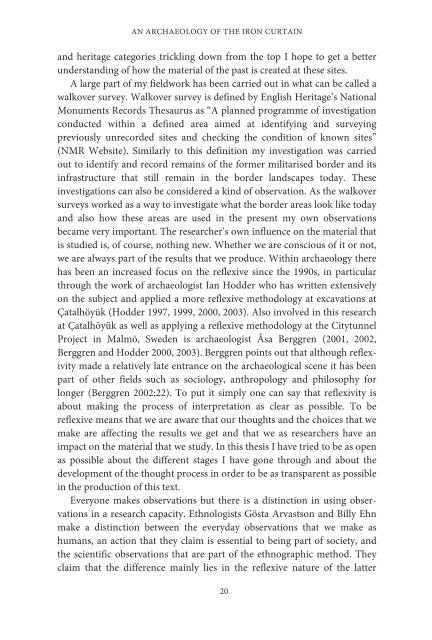1JZGauQ
1JZGauQ
1JZGauQ
You also want an ePaper? Increase the reach of your titles
YUMPU automatically turns print PDFs into web optimized ePapers that Google loves.
AN ARCHAEOLOGY OF THE IRON CURTAIN<br />
and heritage categories trickling down from the top I hope to get a better<br />
understanding of how the material of the past is created at these sites.<br />
A large part of my fieldwork has been carried out in what can be called a<br />
walkover survey. Walkover survey is defined by English Heritage’s National<br />
Monuments Records Thesaurus as “A planned programme of investigation<br />
conducted within a defined area aimed at identifying and surveying<br />
previously unrecorded sites and checking the condition of known sites”<br />
(NMR Website). Similarly to this definition my investigation was carried<br />
out to identify and record remains of the former militarised border and its<br />
infrastructure that still remain in the border landscapes today. These<br />
investigations can also be considered a kind of observation. As the walkover<br />
surveys worked as a way to investigate what the border areas look like today<br />
and also how these areas are used in the present my own observations<br />
became very important. The researcher’s own influence on the material that<br />
is studied is, of course, nothing new. Whether we are conscious of it or not,<br />
we are always part of the results that we produce. Within archaeology there<br />
has been an increased focus on the reflexive since the 1990s, in particular<br />
through the work of archaeologist Ian Hodder who has written extensively<br />
on the subject and applied a more reflexive methodology at excavations at<br />
Çatalhöyük (Hodder 1997, 1999, 2000, 2003). Also involved in this research<br />
at Çatalhöyük as well as applying a reflexive methodology at the Citytunnel<br />
Project in Malmö, Sweden is archaeologist Åsa Berggren (2001, 2002,<br />
Berggren and Hodder 2000, 2003). Berggren points out that although reflexivity<br />
made a relatively late entrance on the archaeological scene it has been<br />
part of other fields such as sociology, anthropology and philosophy for<br />
longer (Berggren 2002:22). To put it simply one can say that reflexivity is<br />
about making the process of interpretation as clear as possible. To be<br />
reflexive means that we are aware that our thoughts and the choices that we<br />
make are affecting the results we get and that we as researchers have an<br />
impact on the material that we study. In this thesis I have tried to be as open<br />
as possible about the different stages I have gone through and about the<br />
development of the thought process in order to be as transparent as possible<br />
in the production of this text.<br />
Everyone makes observations but there is a distinction in using observations<br />
in a research capacity. Ethnologists Gösta Arvastson and Billy Ehn<br />
make a distinction between the everyday observations that we make as<br />
humans, an action that they claim is essential to being part of society, and<br />
the scientific observations that are part of the ethnographic method. They<br />
claim that the difference mainly lies in the reflexive nature of the latter<br />
20




